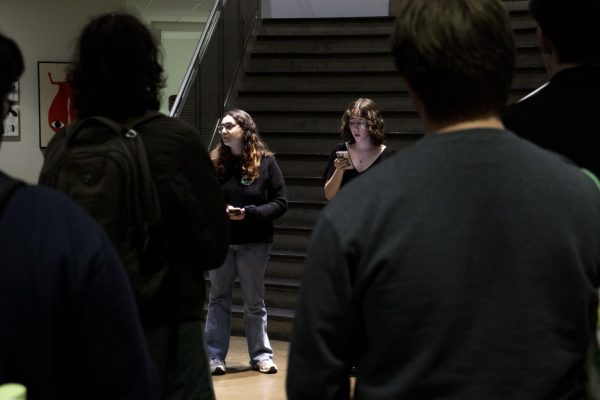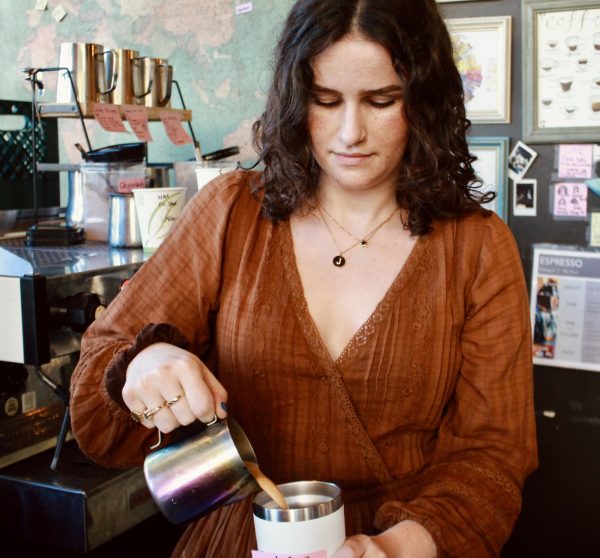The Boys Club: Our Male-Dominated Student Government and Why it Matters
Perhaps by the time our generation reaches political maturity, this gender gap will have closed. But a glance around a classroom in Ward on Sunday afternoon—during the weekly meeting of the AU Undergraduate Senate—might suggest otherwise. Even though the student body is over 60 percent female, only about a third of senate seats are filled by women.
“For a school that’s two-to-one women to men, we should have, proportionally, 20 women in the Senate out of a 30 person body, and right now, with my inclusion, we have eight,” senior Kathryn Baxter said. Before her nomination as an undergraduate senator last November, there were only five.
For many students, AU is part of a direct pipeline into the halls of the national government, and for them, the Student Government campaign trail is a trial run for the real thing. But for a school that is producing the potential leaders of tomorrow, our leadership is not very diverse. While this isn’t a problem unique to AU, the boys’ club that exists on the second floor of MGC provides valuable insight into the system that reproduces the boys’ club downtown.
***
“The under-representation of women at the student government level is not particularly surprising because at all levels of political leadership there’s a substantial gender gap,” said Jennifer Lawless, Director of the Women & Politics Institute. “In the United States Congress, 84 percent of the members are men and 44 of the 50 state governors are men. Ninety-three of the mayors in the 100 largest cities are men.”
Women who run for elected office are just as likely as men to win, but men run significantly more often. “I think men are often socialized to think that they’re competent and women are socialized to question their competency,” said Quinn Pregliasco, director of AU Women’s Initiative.
Research done by Lawless suggests the same thing. “Women and men with the same qualifications don’t assess themselves the same way,” Lawless said. “More than 60 percent of men thought they were qualified for office; fewer than 40 percent of women with the exact same résumés self-assessed that way. Women who don’t think they’re qualified don’t think about running for office. Men who don’t think they’re qualified still give it serious thought.”
***
Some in the AU community are trying to close this gap in representation, at least on campus. Baxter has started a women’s caucus in the Student Government which aims to get more women involved in the senate, increase the participation of current female senators and encourage qualified women to run for seats in upcoming elections.
Also, the Women & Politics Institute has been working toward increasing the representation of women at AU though a program called Campaign College. This program aims to train female students and give them the tools to run for Student Government (males can participate too), and was launched in 2007 to address low female participation. While female representation increased substantially after the launch of the program, this trend hasn’t been sustained.
Though the Student Government is often belittled for its cliquish nature and presumed irrelevance to campus life, the student Senate has real power, allocating over $600,000 every year to the executive branch. And without a substantial female bloc in the senate, a male majority could run roughshod over women’s interests.
Last year, the Budget Committee of the Undergraduate Senate voted unanimously to cut the Women’s Initiative’s budget from $23,000 to $17,000. The debate that ensued when the budget came up for vote was contentious and lasted several hours. In the end, Women’s Initiative’s funds were cut by only $1,000. This is all despite the fact that the group had actually grown and was putting on more—and better attended—programming than the previous year.
The dearth of female leaders in the Student Government may have an impact greater than the outcome of a vote or anything that happens at the university level.
“Based on the research I’ve done with people who are lawyers, business leaders, educators and political activists — which are the careers that lead to political careers in adulthood or post college — if you run for student government you’re about 10 percentage points more likely to consider running for office later in life,” Lawless said. “We are at a point right now that if we can’t up the number of women who run for student government, it’s very difficult to close that gender gap in political ambition 20 or 30 years from now.”
***
At the executive level, the gap is far from closed. For the past three years, the Student Government President has been a straight white male from the School of Public Affairs Leadership Program. Another student fitting this description intends to run in the upcoming presidential election.
“It’s absolutely a mentorship thing,” said President Nate Bronstein, a junior. “In all honesty, I don’t think it’s a coincidence that each president has mentored the one prior, and that person ended up filling their position. That being said, these mentors also mentor more than one person.”
Quinn Pregliasco thinks that the mentorship system can lead to a demographic imbalance in leadership. “So the president or director of the club kind of mentors someone and they get most exposed, and they are the next natural one. I think oftentimes people mentor people they see themselves in,” she said. “So if you’re a white male you’re going to mentor a white male, if you’re a Latino female you’re probably going to want to mentor another Latino female just because you see yourself in them.”
While Bronstein himself may be a white male teaching assistant from the SPA Leadership Program, he boasts of a cabinet that’s more representative of the student body. “More than half of my cabinet is women,” Bronstein said, though he acknowledges there is a gender gap in terms of elected positions. He’s not the first to note that there just aren’t many female candidates.
“I love the initiative Kathryn [Baxter] is putting forth because we need more female candidates,” Bronstein said. “Typically when they run they do pretty well. This year, we’re fortunate enough to have Maia [Tagami], our VP.”
SG fares better when it comes to racial inclusiveness. Around 25 percent of Bronstein’s cabinet and 20 percent of the senate are racial minorities. People of color make up around 20 percent of the AU student body.
***
The shortage of female leaders is not a problem exclusive to Student Government. The executive boards of both College Republicans and College Democrats are comprised entirely of males this semester (though both have at least one vacancy to fill). Within campus media, just short of half of the eight media organizations have female leaders. A number of advocacy groups, however, are headed by women, like Eco-Sense, Colleges Against Cancer and the AU STAND Coalition.
McBride believes that the leadership on campus should represent the makeup of the student body and that leaders as well as individuals should step up to help make that happen.
“I think too often people think that accepting that it’s our responsibility to change it is the same thing as accepting blame, and I don’t think that’s right,” he said.
Of course, AU can’t be faulted for existing in a world dominated by white men. But it would be better if we were the pioneers: changing the system, rather than perpetuating it. The women’s caucus and Campaign College are a good start, but programs like this need to expand to have a lasting impact.
“On college campuses we have a unique opportunity because we make the rules,” Lawless said. “We don’t have to necessarily embrace the way the status quo looks and we don’t need to raise hundreds of thousands of dollars to change that.”
P.S.: It’s not just us — read about SG women at Georgetown here.
Illustration by Hannah Karl







